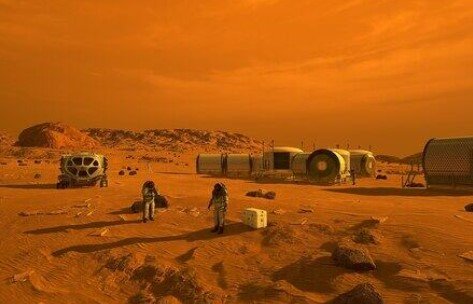
The Science Behind Terraforming: Can We Really Make Mars Habitable?
Terraforming is one of the most ambitious and fascinating ideas humanity has ever conceived. The concept of altering an entire planet to make it habitable for human life has captured the imagination of scientists, writers, and space enthusiasts for decades. As we look beyond Earth for potential new homes, Mars, the Red Planet, stands out as the most likely candidate for terraforming. But can we really make Mars habitable? This article delves into the science behind terraforming, examining the challenges, theories, and possibilities of transforming Mars into a second Earth.
What is Terraforming?
Terraforming, derived from the Latin words “terra” (earth) and “forma” (shape), refers to the process of modifying a planet’s environment to resemble that of Earth. This concept has been a staple of science fiction for years, but it also has roots in serious scientific discussions. The idea is to create conditions where humans could live without the need for life support systems. Historically, the term gained prominence in the 20th century, particularly with the rise of space exploration and the realization that Earth may not always be a safe haven for humanity.
Terraforming involves altering a planet’s atmosphere, temperature, surface, and ecology to make it more Earth-like. This could potentially include increasing the atmospheric pressure, warming the planet, introducing water, and eventually, growing vegetation. The ultimate goal is to create a self-sustaining ecosystem that could support human life.
Why Mars? The Case for Terraforming the Red Planet
Mars is often considered the best candidate for terraforming due to its similarities with Earth. It is the fourth planet from the Sun and has a day length similar to Earth’s. Moreover, Mars has polar ice caps, seasons, and a variety of surface features like valleys and mountains that are reminiscent of our home planet. However, Mars is also a hostile environment with a thin atmosphere, extreme cold, and no liquid water on its surface.
Compared to other planets and moons in our solar system, Mars is relatively close and has a more stable climate. Venus, while closer in size to Earth, has a toxic atmosphere and surface temperatures that are hot enough to melt lead, making it a much more challenging candidate for terraforming. The Moon, while nearby, lacks an atmosphere and is too small to retain one, even if created artificially.
Mars presents a more feasible option, with its potential to hold an atmosphere and its history of water presence, evidenced by ancient river valleys and lake beds. These factors make Mars an intriguing target for those looking to expand humanity’s footprint beyond Earth.
Current Understanding of Mars’ Environment
Mars’ environment is starkly different from Earth’s. Its atmosphere is composed of 95% carbon dioxide, with traces of nitrogen and argon, but it lacks the oxygen necessary for human life. The atmospheric pressure on Mars is less than 1% of Earth’s, which means water cannot exist as a liquid for long on its surface; it either freezes or evaporates almost immediately.
Temperatures on Mars are extreme, ranging from -125°C (-195°F) at the poles during winter to a maximum of 20°C (68°F) at the equator during summer. Dust storms are common, sometimes covering the entire planet for weeks. These storms, combined with the planet’s low gravity—about 38% of Earth’s—create a challenging environment for potential colonists.
Additionally, Mars lacks a global magnetic field, which on Earth protects the atmosphere and surface from the Sun’s harmful solar wind and cosmic radiation. This absence has resulted in the thinning of Mars’ atmosphere over billions of years, making it less capable of supporting life.
Theories and Concepts of Terraforming Mars
Several theories have been proposed for terraforming Mars, each with its own set of scientific and technical challenges. One of the most discussed methods involves releasing greenhouse gases, such as CO2, into the atmosphere to warm the planet—a process similar to the greenhouse effect on Earth. The idea is to trigger a runaway effect that would thicken the atmosphere and increase surface temperatures, making the planet more hospitable.
Another concept is the use of large mirrors in space to reflect sunlight onto the Martian surface, thereby raising temperatures. This method would require immense engineering feats but could potentially accelerate the warming process.
Some scientists suggest importing ammonia-rich asteroids or comets to Mars. Upon impact, these bodies would release gases that could contribute to atmospheric thickening and warming. However, this approach comes with significant risks, including the potential for unintended consequences on Mars’ surface and climate.
Finally, there is the idea of using synthetic biology to introduce microorganisms that could survive on Mars and gradually alter its atmosphere by producing oxygen. While this method is still in the realm of theoretical science, advancements in genetic engineering could one day make it possible.
Altering Mars’ Atmosphere
To make Mars habitable, one of the first steps would be to alter its atmosphere. This involves increasing the atmospheric pressure to a level where liquid water could exist on the surface. Several methods have been proposed to achieve this.
One approach is to release large amounts of CO2 trapped in Mars’ polar ice caps and soil. This could be done by warming the planet using nuclear detonations or large mirrors to direct sunlight onto the ice caps. As the CO2 is released, it would thicken the atmosphere and create a greenhouse effect, trapping heat and further warming the planet.
Another method involves introducing chlorofluorocarbons (CFCs) or other potent greenhouse gases into the Martian atmosphere. These gases, although harmful to Earth’s ozone layer, could be used to artificially warm Mars. However, this would require manufacturing or transporting vast amounts of these gases, which is a significant technical challenge.
A more futuristic approach is the idea of constructing massive factories on Mars that would continuously pump greenhouse gases into the atmosphere. These factories could be powered by nuclear energy or solar power, providing a sustained effort to alter the planet’s climate over centuries.
The Role of Greenhouse Gases in Terraforming Mars
Greenhouse gases are crucial in the process of terraforming because they can trap heat in a planet’s atmosphere, leading to a rise in surface temperature. On Mars, the idea is to replicate the greenhouse effect that occurs naturally on Earth, albeit in a controlled and deliberate manner.
Carbon dioxide (CO2) is the most readily available greenhouse gas on Mars, found in abundance in the planet’s atmosphere and polar ice caps. By releasing CO2, either through artificial means or natural processes, it is hoped that Mars’ atmosphere could be thickened, increasing the planet’s ability to retain heat.
Methane (CH4) is another potent greenhouse gas that could play a role in terraforming. Although methane is present in small amounts on Mars, introducing more of it, perhaps through biological means such as methane-producing bacteria, could enhance the greenhouse effect.
Water vapor (H2O) is also a powerful greenhouse gas. If we could create stable bodies of water on Mars, the evaporation would contribute to warming the atmosphere. This, in turn, could lead to a positive feedback loop, where increased temperatures result in more water vapor and further warming.
The challenge, however, is controlling these processes in a way that leads to a stable and habitable environment. Too much warming could lead to runaway effects, while too little might not be enough to sustain liquid water or support life.
Creating Liquid Water on Mars
One of the most significant challenges in making Mars habitable is the creation and maintenance of liquid water. Mars currently has water in the form of ice, particularly at its poles, but liquid water is essential for life as we know it.
To create liquid water, the surface temperature of Mars would need to be raised above the freezing point. This could be achieved through the greenhouse effect, as discussed earlier. Another approach is to directly melt the polar ice caps using orbital mirrors or by releasing CO2 to create a thicker atmosphere.
Maintaining liquid water, however, is a more complex issue. Mars’ low atmospheric pressure means that water would quickly evaporate or freeze. To counter this, we would need to significantly increase the atmospheric pressure, which would likely require releasing vast amounts of gases into the atmosphere or building protective domes over bodies of water.
Introducing large bodies of water would also require managing the salinity and chemistry of Martian water, which could differ significantly from Earth’s due to the presence of various minerals and salts on Mars.
Introducing Vegetation and Plant Life
Plants are a key component of any ecosystem, playing a crucial role in converting CO2 into oxygen through photosynthesis. Introducing vegetation to Mars would be a significant step toward making the planet habitable, but it comes with several challenges.
Mars’ thin atmosphere and lack of oxygen mean that Earth plants cannot survive there as they are. However, through genetic engineering, it might be possible to create plants that can thrive in Mars’ environment. These plants would need to be resistant to extreme cold, high levels of radiation, and the low atmospheric pressure on Mars.
One approach could involve using hardy plants like lichens and extremophiles, which can survive in some of Earth’s harshest environments, as initial colonizers. These organisms could help to gradually transform the Martian soil, making it more hospitable for other plants.
As the atmosphere thickens and warms, more complex plants could be introduced. The ultimate goal would be to create a self-sustaining biosphere on Mars, where plants could grow, reproduce, and contribute to the oxygenation of the atmosphere.
Using Technology to Accelerate Terraforming
Terraforming Mars is an enormous undertaking that could benefit from the use of advanced technology. Artificial intelligence (AI), robotics, and nanotechnology are all areas that could play crucial roles in accelerating the process.
AI could be used to model and predict the outcomes of various terraforming strategies, helping scientists to optimize the processes involved. For example, AI algorithms could simulate the effects of releasing greenhouse gases on Mars’ climate over centuries, providing insights that would be impossible to obtain through traditional methods.
Robotics could be employed to carry out the labor-intensive tasks of building infrastructure, planting vegetation, and monitoring environmental conditions on Mars. These robots could operate autonomously, reducing the need for human presence in the early stages of terraforming.
Nanotechnology offers the potential to manipulate materials at the atomic level, creating new substances that could be used in the construction of domes, habitats, or even in the atmospheric engineering of Mars. Nanobots could also be used to repair damage or to monitor and maintain the stability of the Martian environment.
Ethical Considerations in Terraforming Mars
The idea of terraforming Mars raises significant ethical questions. Is it right for humanity to alter an entire planet for our own purposes? What are the potential consequences for any existing Martian life forms, even if they are only microbial?
One ethical argument against terraforming is that it could destroy any existing ecosystems on Mars, no matter how simple. If life exists on Mars, even in microbial form, altering the environment could lead to its extinction. This raises questions about our responsibility to protect other forms of life, no matter how different from our own.
There is also the question of planetary rights. Does Mars have an intrinsic right to remain unchanged? Some argue that humanity should explore Mars and other planets without altering them, preserving their natural states for future generations to study.
On the other hand, proponents of terraforming argue that humanity has a duty to ensure its survival, and that expanding to other planets could provide a backup plan in case of global catastrophes on Earth. They also suggest that the knowledge and technology gained from terraforming could benefit Earth by helping us address our environmental challenges.
The Timeline: How Long Would It Take to Terraform Mars?
Terraforming Mars is not a quick process; it could take centuries, if not millennia, to complete. The exact timeline depends on the methods used, the scale of the project, and the technological advancements that occur along the way.
If we were to rely solely on natural processes, such as releasing CO2 from Mars’ ice caps, the process could take hundreds of thousands of years. However, with the use of advanced technology, this timeline could be significantly reduced.
For example, deploying orbital mirrors to focus sunlight on Mars could start warming the planet within a few decades. The introduction of greenhouse gases might take a century or more to produce noticeable effects. Creating and maintaining liquid water, along with introducing plant life, could add several more centuries to the timeline.
Some optimistic projections suggest that with the right technological breakthroughs, we could see the beginnings of a habitable Mars within a few hundred years. However, this would require unprecedented levels of global cooperation, funding, and commitment.
Potential Challenges and Obstacles
Terraforming Mars presents a host of challenges, from scientific and technical issues to political and economic hurdles. One of the biggest scientific challenges is the lack of a magnetic field on Mars, which makes the planet vulnerable to solar wind and cosmic radiation. Without a magnetic field, any atmosphere we create could be stripped away over time.
Technical challenges include the construction and maintenance of the infrastructure needed to alter Mars’ environment. This includes everything from factories that produce greenhouse gases to systems that could transport and release asteroids or comets.
Political challenges are also significant. Terraforming Mars would require global cooperation, as no single nation or organization has the resources to undertake such a massive project on its own. There would need to be agreements on how to govern Mars, who has the right to claim its resources, and how the benefits of terraforming would be shared.
Finally, economic challenges cannot be overlooked. The cost of terraforming Mars would be astronomical, requiring investment from both governments and the private sector. Funding such a project over centuries would require long-term planning and a stable commitment that transcends political changes and economic downturns.
Economic and Political Aspects of Terraforming Mars
The economics of terraforming Mars is as complex as the science behind it. The costs of transporting materials, building infrastructure, and maintaining a sustained effort over centuries are immense. However, there are potential economic benefits as well, such as the mining of Martian resources and the development of new technologies that could be used on Earth.
Political aspects are equally challenging. Terraforming Mars would require international cooperation on a scale never before seen. Questions of sovereignty, governance, and the distribution of benefits would need to be addressed. Would Mars be governed by a global organization, or would it become a colony of Earth? Who would have the right to decide how the planet is terraformed and who gets to live there?
There is also the issue of space law. The Outer Space Treaty of 1967, which is still in force, prohibits any nation from claiming sovereignty over a celestial body. This means that no single country could claim ownership of Mars, complicating efforts to coordinate a terraforming project.
Private companies, such as SpaceX, have also expressed interest in Mars, raising questions about the role of the private sector in the terraforming process. How would profits be shared? What regulations would be in place to ensure that the interests of all humanity are considered?
Learning from Earth: Applying Ecological Principles
As we consider terraforming Mars, it is essential to learn from the environmental challenges we face on Earth. Our planet is currently undergoing significant ecological changes due to human activity, and these lessons must be applied to any efforts to terraform another world.
Sustainability is key. Any terraforming project must consider the long-term health of Mars’ environment, avoiding the mistakes made on Earth. This includes managing resources carefully, preventing pollution, and ensuring that any introduced species or ecosystems are stable and self-sustaining.
Ecological principles, such as the importance of biodiversity and the interdependence of species, should guide the introduction of life to Mars. Creating a balanced ecosystem that can thrive without constant human intervention will be crucial to the success of terraforming.
Furthermore, we must be mindful of the potential for unintended consequences. On Earth, the introduction of non-native species has often led to ecological disasters. The same could happen on Mars if we are not careful in selecting which organisms to introduce and how they are managed.
The Role of Space Agencies and Private Sector
The success of any terraforming project will depend on the collaboration between space agencies and the private sector. NASA, ESA, and other national space agencies have the scientific expertise and experience needed to lead such an effort. However, the involvement of private companies like SpaceX could provide the innovation, funding, and momentum needed to make terraforming a reality.
NASA’s role could involve conducting preliminary research, developing the necessary technologies, and overseeing the scientific aspects of the project. ESA and other international partners could contribute their expertise and resources, ensuring that the project is a truly global effort.
The private sector, on the other hand, could play a crucial role in funding the project, particularly in the early stages. Companies like SpaceX have already demonstrated their interest in Mars, with plans to send humans to the planet within the next few decades. Private companies could also drive innovation, developing new technologies and approaches that could accelerate the terraforming process.
Collaboration between public and private entities will be essential, with clear agreements on roles, responsibilities, and the sharing of benefits.
Alternatives to Terraforming Mars
Terraforming Mars is a monumental task, and some argue that there may be easier or more practical alternatives. One option is the construction of space habitats, such as O’Neill cylinders or Stanford tori, which could provide habitable environments in space without the need to alter an entire planet.
These space habitats could be built using materials from asteroids or the Moon and could be designed to replicate Earth’s environment. They would be self-contained ecosystems, with artificial gravity, controlled atmospheres, and all the amenities needed for human life.
Another alternative is the establishment of bases on the Moon or other celestial bodies. The Moon is much closer to Earth than Mars, making it easier to transport materials and personnel. While the Moon lacks an atmosphere, it could serve as a stepping stone for further exploration and colonization of the solar system.
Finally, some scientists suggest that instead of terraforming Mars, we should focus on protecting and preserving Earth. The resources and effort required to terraform another planet could be used to address environmental issues on Earth, ensuring that our home planet remains habitable for future generations.
Terraforming in Popular Culture
Terraforming has been a popular theme in science fiction for decades, with numerous books, movies, and video games exploring the concept. These stories often highlight the challenges and moral dilemmas associated with altering a planet’s environment.
One of the earliest examples is Kim Stanley Robinson’s “Mars Trilogy,” which provides a detailed and scientifically grounded exploration of the terraforming process. The trilogy delves into the technical challenges, political struggles, and ethical questions involved in transforming Mars.
Movies like “Total Recall” and “The Martian” have also touched on the idea of terraforming, albeit in more fantastical or simplified ways. These portrayals often emphasize the dangers and unpredictability of such a massive undertaking.
Video games like “Sid Meier’s Civilization: Beyond Earth” and “Surviving Mars” allow players to experiment with terraforming on a smaller scale, exploring the strategic and logistical challenges involved.
While these fictional portrayals often take liberties with the science, they have helped to popularize the idea of terraforming and have inspired many to consider the possibilities of life on other planets.
Scientific Discoveries that Could Change Terraforming
Scientific discoveries are constantly reshaping our understanding of the universe and could have a significant impact on the feasibility of terraforming Mars. Breakthroughs in fields such as astrophysics, biology, and materials science could either accelerate or halt our efforts to make Mars habitable.
One area of interest is the discovery of extremophiles—organisms that can survive in extreme environments on Earth. These organisms could provide clues on how to engineer life forms capable of thriving on Mars.
Advances in genetic engineering could also play a role. By modifying the DNA of plants and microorganisms, we might be able to create species specifically tailored to the Martian environment, capable of contributing to the terraforming process.
In materials science, the development of new, lightweight, and durable materials could make the construction of habitats and other infrastructure on Mars more feasible. These materials could protect against radiation, withstand the harsh Martian climate, and facilitate the transport of goods and equipment from Earth.
Discoveries in energy production, such as more efficient solar panels or new forms of nuclear power, could also provide the energy needed to sustain life and drive the terraforming process on Mars.
For more information, visit here: https://forenzapper.net/
Mars as a Backup Plan: Is it Worth the Effort?
The idea of terraforming Mars is often framed as a backup plan for humanity, a way to ensure our survival in the event of a global catastrophe on Earth. But is it worth the effort?
On one hand, creating a habitable Mars could provide a new frontier for humanity, offering opportunities for exploration, scientific discovery, and the expansion of human civilization. It could serve as a safety net, a place where humanity could start anew if Earth becomes uninhabitable.
On the other hand, the resources and time required to terraform Mars are immense, and there is no guarantee of success. Some argue that these resources would be better spent on preserving and improving conditions on Earth, addressing the environmental, social, and political challenges we face here.
Furthermore, the ethical questions surrounding terraforming cannot be ignored. Altering an entire planet could have unforeseen consequences, not only for Mars but for the solar system as a whole. The decision to terraform Mars should not be taken lightly, and it must involve careful consideration of the risks and benefits.
The Future of Terraforming and Human Colonization
The future of terraforming and human colonization of Mars is still uncertain, but the idea continues to captivate scientists, engineers, and the general public. As technology advances and our understanding of Mars deepens, the possibility of making the Red Planet habitable becomes more plausible.
In the coming decades, we may see the first human missions to Mars, laying the groundwork for future colonization efforts. These missions will provide valuable data on Mars’ environment, helping us to refine our plans for terraforming.
Ultimately, the success of terraforming Mars will depend on our ability to work together as a species, leveraging our collective knowledge, resources, and creativity. Whether or not we succeed, the pursuit of this goal will push the boundaries of science and technology, offering new insights into the possibilities of life beyond Earth.
FAQs
What is terraforming, and why is Mars the primary target?
Terraforming is the process of altering a planet’s environment to make it more Earth-like. Mars is considered the primary target due to its similarities to Earth, such as its day length, polar ice caps, and evidence of past water presence.
How long would it take to terraform Mars?
Terraforming Mars could take centuries or even millennia, depending on the methods used and technological advancements. Estimates range from a few hundred years to over 100,000 years.
What are the main challenges in terraforming Mars?
The main challenges include Mars’ thin atmosphere, lack of a magnetic field, extreme temperatures, and the need for significant technological and economic resources. Ethical and political issues also pose challenges.
Could introducing vegetation to Mars create an oxygen-rich atmosphere?
Introducing vegetation could help produce oxygen, but it would require genetically engineered plants capable of surviving Mars’ harsh conditions. The process would take a long time and would need to be part of a larger effort to alter the planet’s atmosphere.
Are there alternatives to terraforming Mars?
Alternatives include building space habitats, establishing bases on the Moon, or focusing on preserving Earth’s environment. These options may be more feasible in the near term.
What role does the private sector play in terraforming Mars?
The private sector, particularly companies like SpaceX, could provide funding, innovation, and momentum for terraforming efforts. Collaboration with space agencies and international partners will be essential.
Conclusion
Terraforming Mars is one of the most ambitious projects humanity has ever considered. While the science and technology needed to make Mars habitable are still in their infancy, the potential rewards are immense. However, the challenges are equally significant, from technical and scientific hurdles to ethical and political dilemmas. Whether we ultimately succeed in transforming the Red Planet into a second Earth or not, the pursuit of this goal will undoubtedly push the boundaries of human knowledge and capability. As we continue to explore the possibilities, the dream of making Mars habitable remains one of the most compelling visions of our future in space.




